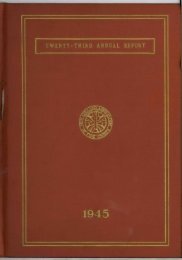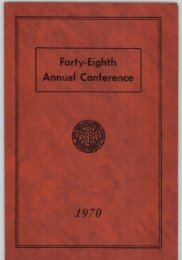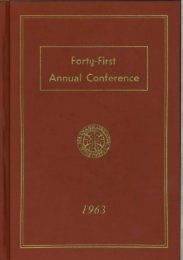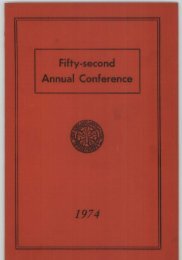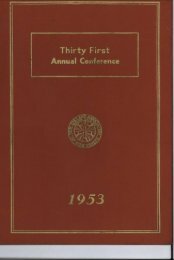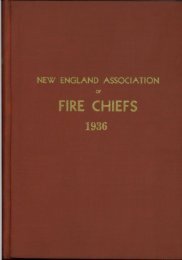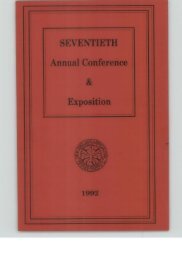NEAFC 32nd Annual Conference.pdf - New England Association of ...
NEAFC 32nd Annual Conference.pdf - New England Association of ...
NEAFC 32nd Annual Conference.pdf - New England Association of ...
You also want an ePaper? Increase the reach of your titles
YUMPU automatically turns print PDFs into web optimized ePapers that Google loves.
NEW ENGLAlXlD .ASSOCIATION OF FII,,E CHIEFS<br />
We have discussed the blast damage zone radii, and noted that these radii<br />
scale up approximately with the cube root o£ the yield <strong>of</strong> the atomic or’hydrogen<br />
bomb. I am sure you .are wondering whether the zones <strong>of</strong> interest, as<br />
,regards incendiary action, should follow the same law.<br />
The subject is complicated by the varying attenuation effects <strong>of</strong> the<br />
Slight .haze normally present in the atmosphere. This. always; limits the range<br />
<strong>of</strong> atmosphere visibility. When you can see only a few miles, the incendiary<br />
effect <strong>of</strong> even the largest bombs cannot well extend much farther.<br />
_As a practical working principle, you can, therefore, count on fighting<br />
incendiary effects in the same blast damage zones for large bombs as for small<br />
bombs. With houses demolished in the zone <strong>of</strong> A-damage, and streets obstructed<br />
by rubble <strong>of</strong> the zone <strong>of</strong> B-damage, the zones <strong>of</strong> major interest to<br />
fire fighters will normally be the zones <strong>of</strong> C and D damage,, where we would<br />
expect moderate to minor blast damage. Be ready, therefore, with the super<br />
bombs to plan to fight fires in the correspondingly enlarged zones <strong>of</strong> C and D<br />
damage. However, if the visibility is rather low at the time <strong>of</strong> any bomb drop,<br />
the area o£ incendiary action from the primary effects <strong>of</strong> the bomb rriay not<br />
extend out much farther than the zone <strong>of</strong> B damage. I emphasize that even<br />
though this situation should occur, we would have many secondary fires, in<br />
the C and D zones, due to blast disruption.<br />
You have heard, also, the most alarming things about the nuclear radiation<br />
hazard involved in the explosion <strong>of</strong> the H-bomb. May I say in this connection<br />
that it is probable that due to the size <strong>of</strong> the fire bail .(probably touching the<br />
ground), the radiation hazard may be intensified. However, there is no new<br />
type <strong>of</strong> hazard involved in this. type <strong>of</strong> explosion. The difference will be one<br />
o]? intensity. Furthermore, the hazard <strong>of</strong> fall-out may be intensified. The<br />
much publicized case <strong>of</strong> the Japanese fishermen is an example. The fall-out<br />
was not widespread, but seemed to be localized, which is typical <strong>of</strong> fall-out.<br />
I have ~here with me a copy <strong>of</strong> the much discussed film, "Operation Ivy,"<br />
Some <strong>of</strong> you may have seen this, but, undoubtedly, many <strong>of</strong> you have not, and<br />
I should like to s:how it to you. However, before I do that, I want to tell you<br />
something about the research and the tests that we made in Nevada last spring<br />
to learn more about the kind o~ materials that are primarily ignited by the<br />
flash <strong>of</strong> the bomb, and the numbers and arrangement <strong>of</strong> such materials, which<br />
would be exposed to the flash. We demonstrated that solid wood surfaces and<br />
other common building materials are not-expected to be ignited directly by<br />
atomic bomb thermal radiation; beyond the range <strong>of</strong> substantial blast damage.<br />
Only those materials which we call kindling fuels, wi.ll be initially ignited. And,<br />
for the purposes ~<strong>of</strong> our study <strong>of</strong> this problem, we divide kindling fuels into<br />
three classes, as follows:<br />
1. Transient exteridr fuels, materials such as dead grass., fallen leaves,<br />
and discarded papers, which are found in outdoor locations and whose<br />
occurrence varies over a period <strong>of</strong> time.<br />
2. Fixed exterior fuels, materials functioning as an integral part <strong>of</strong><br />
fixed structures., such as rotted wood fences.<br />
3. Interior fuels, building contents such as window coverings, up~<br />
holstery, fabrics, magazines, and newspapers.<br />
Prior to our tests in Nevada <strong>of</strong> last spring, we made a study <strong>of</strong> six major<br />
185



